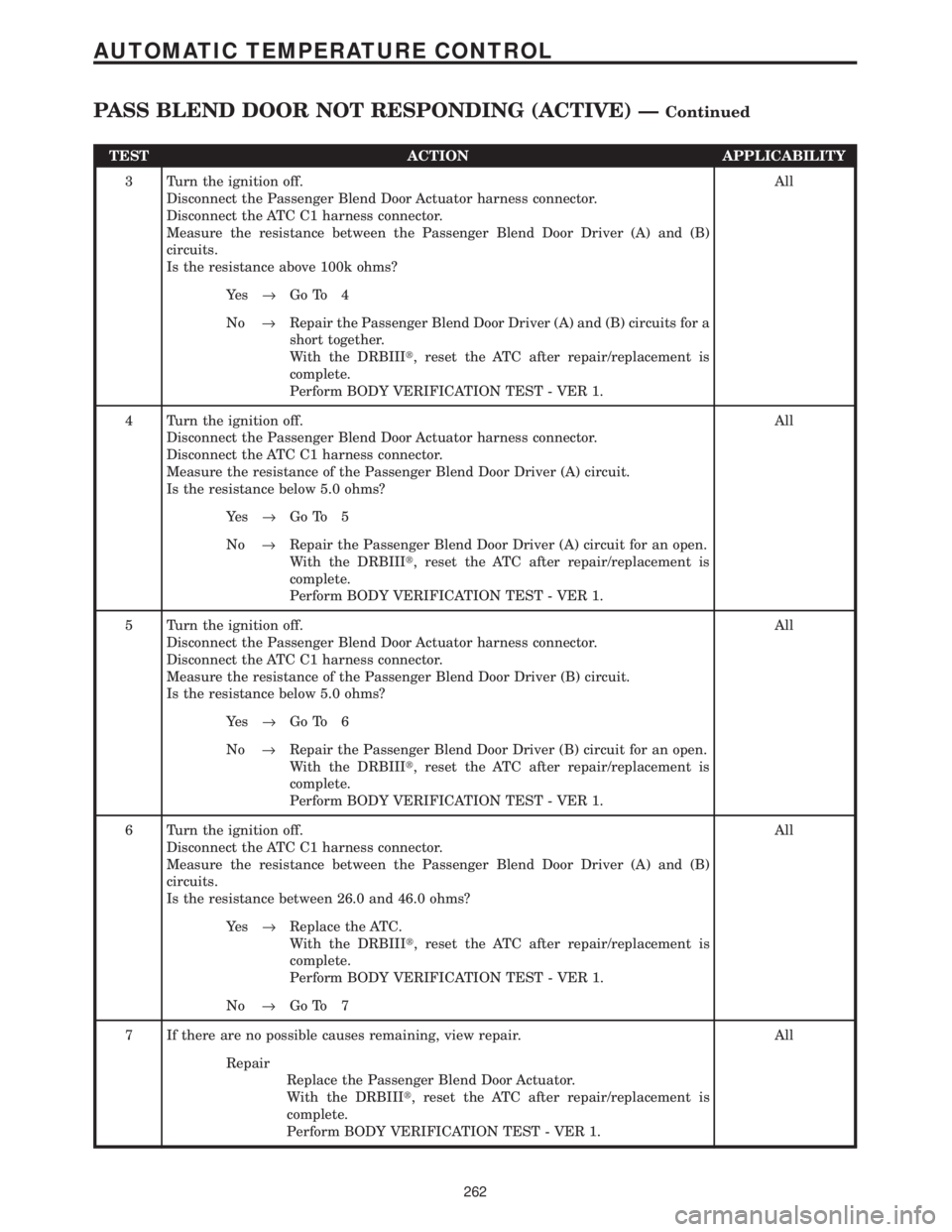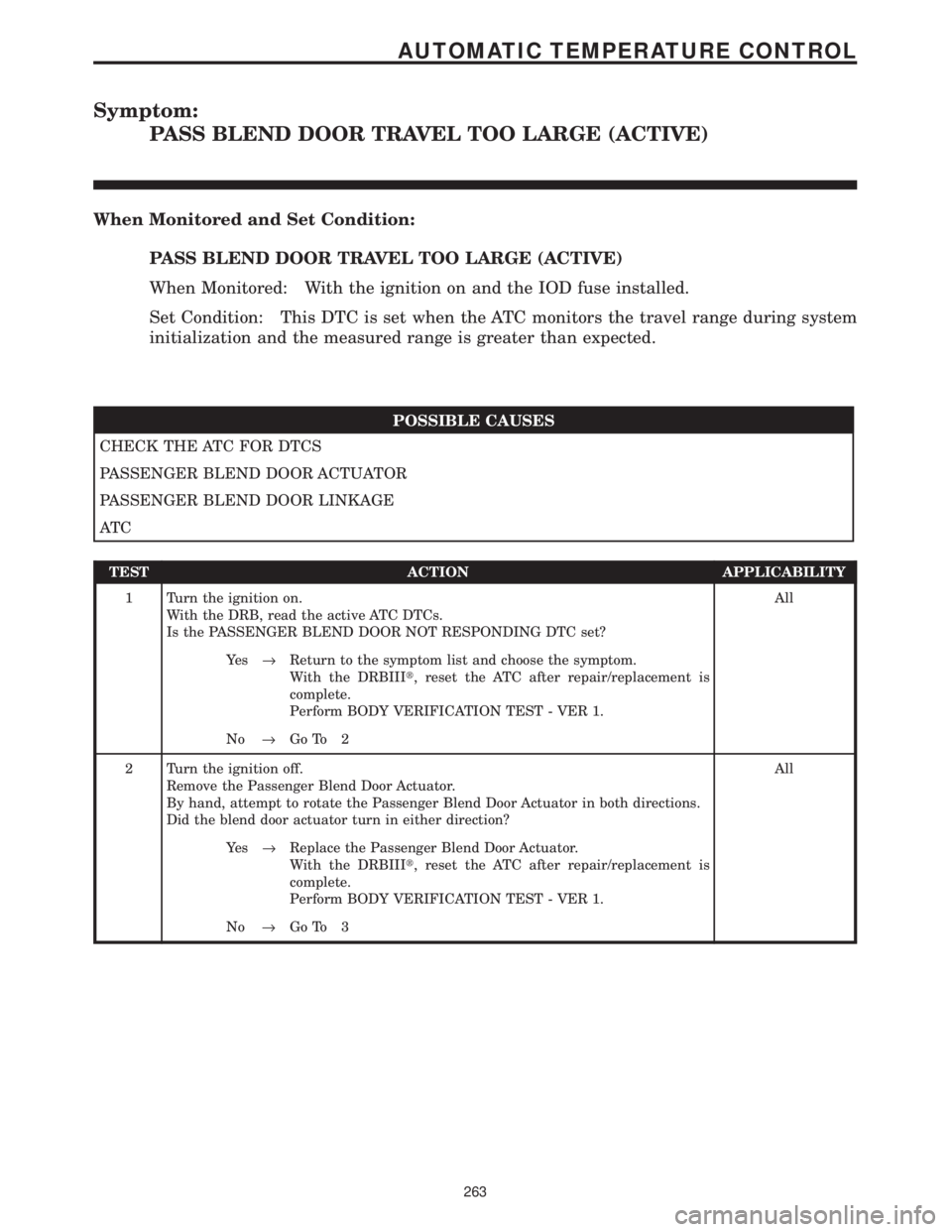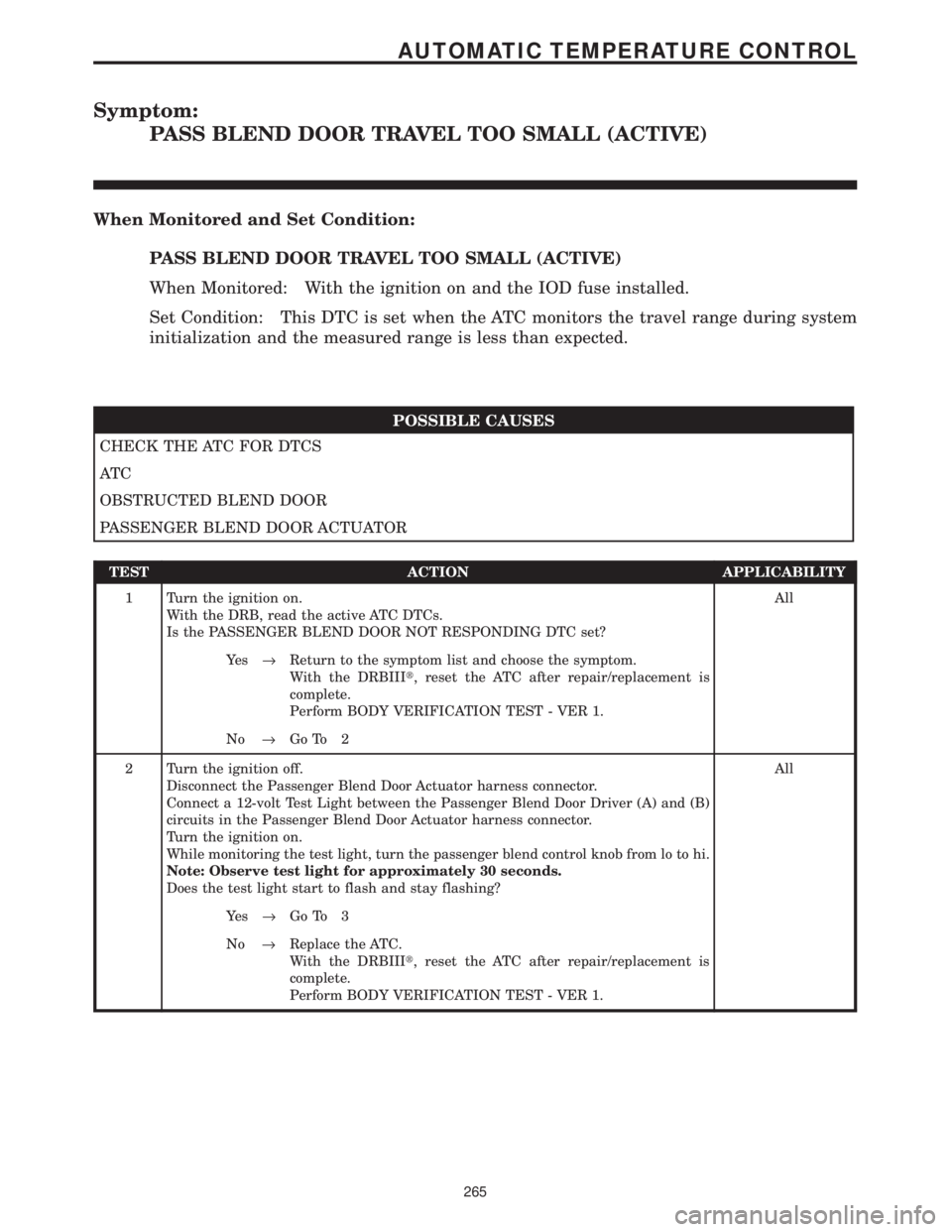2001 CHRYSLER VOYAGER ESP
[x] Cancel search: ESPPage 291 of 4284

TEST ACTION APPLICABILITY
3 Turn the ignition off.
Disconnect the Passenger Blend Door Actuator harness connector.
Disconnect the ATC C1 harness connector.
Measure the resistance between the Passenger Blend Door Driver (A) and (B)
circuits.
Is the resistance above 100k ohms?All
Ye s®Go To 4
No®Repair the Passenger Blend Door Driver (A) and (B) circuits for a
short together.
With the DRBIIIt, reset the ATC after repair/replacement is
complete.
Perform BODY VERIFICATION TEST - VER 1.
4 Turn the ignition off.
Disconnect the Passenger Blend Door Actuator harness connector.
Disconnect the ATC C1 harness connector.
Measure the resistance of the Passenger Blend Door Driver (A) circuit.
Is the resistance below 5.0 ohms?All
Ye s®Go To 5
No®Repair the Passenger Blend Door Driver (A) circuit for an open.
With the DRBIIIt, reset the ATC after repair/replacement is
complete.
Perform BODY VERIFICATION TEST - VER 1.
5 Turn the ignition off.
Disconnect the Passenger Blend Door Actuator harness connector.
Disconnect the ATC C1 harness connector.
Measure the resistance of the Passenger Blend Door Driver (B) circuit.
Is the resistance below 5.0 ohms?All
Ye s®Go To 6
No®Repair the Passenger Blend Door Driver (B) circuit for an open.
With the DRBIIIt, reset the ATC after repair/replacement is
complete.
Perform BODY VERIFICATION TEST - VER 1.
6 Turn the ignition off.
Disconnect the ATC C1 harness connector.
Measure the resistance between the Passenger Blend Door Driver (A) and (B)
circuits.
Is the resistance between 26.0 and 46.0 ohms?All
Ye s®Replace the ATC.
With the DRBIIIt, reset the ATC after repair/replacement is
complete.
Perform BODY VERIFICATION TEST - VER 1.
No®Go To 7
7 If there are no possible causes remaining, view repair. All
Repair
Replace the Passenger Blend Door Actuator.
With the DRBIIIt, reset the ATC after repair/replacement is
complete.
Perform BODY VERIFICATION TEST - VER 1.
262
AUTOMATIC TEMPERATURE CONTROL
PASS BLEND DOOR NOT RESPONDING (ACTIVE) ÐContinued
Page 292 of 4284

Symptom:
PASS BLEND DOOR TRAVEL TOO LARGE (ACTIVE)
When Monitored and Set Condition:
PASS BLEND DOOR TRAVEL TOO LARGE (ACTIVE)
When Monitored: With the ignition on and the IOD fuse installed.
Set Condition: This DTC is set when the ATC monitors the travel range during system
initialization and the measured range is greater than expected.
POSSIBLE CAUSES
CHECK THE ATC FOR DTCS
PASSENGER BLEND DOOR ACTUATOR
PASSENGER BLEND DOOR LINKAGE
AT C
TEST ACTION APPLICABILITY
1 Turn the ignition on.
With the DRB, read the active ATC DTCs.
Is the PASSENGER BLEND DOOR NOT RESPONDING DTC set?All
Ye s®Return to the symptom list and choose the symptom.
With the DRBIIIt, reset the ATC after repair/replacement is
complete.
Perform BODY VERIFICATION TEST - VER 1.
No®Go To 2
2 Turn the ignition off.
Remove the Passenger Blend Door Actuator.
By hand, attempt to rotate the Passenger Blend Door Actuator in both directions.
Did the blend door actuator turn in either direction?All
Ye s®Replace the Passenger Blend Door Actuator.
With the DRBIIIt, reset the ATC after repair/replacement is
complete.
Perform BODY VERIFICATION TEST - VER 1.
No®Go To 3
263
AUTOMATIC TEMPERATURE CONTROL
Page 294 of 4284

Symptom:
PASS BLEND DOOR TRAVEL TOO SMALL (ACTIVE)
When Monitored and Set Condition:
PASS BLEND DOOR TRAVEL TOO SMALL (ACTIVE)
When Monitored: With the ignition on and the IOD fuse installed.
Set Condition: This DTC is set when the ATC monitors the travel range during system
initialization and the measured range is less than expected.
POSSIBLE CAUSES
CHECK THE ATC FOR DTCS
AT C
OBSTRUCTED BLEND DOOR
PASSENGER BLEND DOOR ACTUATOR
TEST ACTION APPLICABILITY
1 Turn the ignition on.
With the DRB, read the active ATC DTCs.
Is the PASSENGER BLEND DOOR NOT RESPONDING DTC set?All
Ye s®Return to the symptom list and choose the symptom.
With the DRBIIIt, reset the ATC after repair/replacement is
complete.
Perform BODY VERIFICATION TEST - VER 1.
No®Go To 2
2 Turn the ignition off.
Disconnect the Passenger Blend Door Actuator harness connector.
Connect a 12-volt Test Light between the Passenger Blend Door Driver (A) and (B)
circuits in the Passenger Blend Door Actuator harness connector.
Turn the ignition on.
While monitoring the test light, turn the passenger blend control knob from lo to hi.
Note: Observe test light for approximately 30 seconds.
Does the test light start to flash and stay flashing?All
Ye s®Go To 3
No®Replace the ATC.
With the DRBIIIt, reset the ATC after repair/replacement is
complete.
Perform BODY VERIFICATION TEST - VER 1.
265
AUTOMATIC TEMPERATURE CONTROL
Page 297 of 4284

Symptom:
REAR BLEND DOOR NOT RESPONDING (ACTIVE)
When Monitored and Set Condition:
REAR BLEND DOOR NOT RESPONDING (ACTIVE)
When Monitored: With the ignition on and the IOD fuse installed.
Set Condition: This DTC is set if the ATC does not receive feedback pulses within 5
seconds of the drive voltage being applied.
POSSIBLE CAUSES
REAR BLEND DOOR DRIVER CIRCUIT (A) SHORTED TO GROUND
REAR BLEND DOOR DRIVER CIRCUIT (B) SHORTED TO GROUND
REAR BLEND DOOR DRIVER CIRCUITS (A) AND (B) SHORTED TOGETHER
REAR BLEND DOOR DRIVER CIRCUIT (A) OPEN
REAR BLEND DOOR DRIVER CIRCUIT (B) OPEN
AT C
REAR BLEND DOOR ACTUATOR
TEST ACTION APPLICABILITY
1 Turn the ignition off.
Disconnect the Rear Blend Door Actuator harness connector.
Disconnect the ATC C1 harness connector.
Measure the resistance between ground and the Rear Blend Door Driver (A) circuit.
Is the resistance above 100k ohms?All
Ye s®Go To 2
No®Repair the Rear Blend Door Driver (A) circuit for a short to
ground.
With the DRBIIIt, reset the ATC after repair/replacement is
complete.
Perform BODY VERIFICATION TEST - VER 1.
2 Turn the ignition off.
Disconnect the Rear Blend Door Actuator harness connector.
Disconnect the ATC C1 harness connector.
Measure the resistance between ground and the Rear Blend Door Driver (B) circuit.
Is the resistance above 100k ohms?All
Ye s®Go To 3
No®Repair the Rear Blend Door Driver (B) circuit for a short to
ground.
With the DRBIIIt, reset the ATC after repair/replacement is
complete.
Perform BODY VERIFICATION TEST - VER 1.
268
AUTOMATIC TEMPERATURE CONTROL
Page 298 of 4284

TEST ACTION APPLICABILITY
3 Turn the ignition off.
Disconnect the Rear Blend Door Actuator harness connector.
Disconnect the ATC C1 harness connectors.
Measure the resistance between the Rear Blend Door Driver (A) and (B) circuits.
Is the resistance above 100k ohms?All
Ye s®Go To 4
No®Repair the Rear Blend Door Driver (A) and (B) circuits for a short
together.
With the DRBIIIt, reset the ATC after repair/replacement is
complete.
Perform BODY VERIFICATION TEST - VER 1.
4 Turn the ignition off.
Disconnect the Rear Blend Door Actuator harness connector.
Disconnect the ATC C1 harness connector.
Measure the resistance of the Rear Blend Door Driver (A) circuit.
Is the resistance below 5.0 ohms?All
Ye s®Go To 5
No®Repair the Rear Blend Door Driver (A) circuit for an open.
With the DRBIIIt, reset the ATC after repair/replacement is
complete.
Perform BODY VERIFICATION TEST - VER 1.
5 Turn the ignition off.
Disconnect the Rear Blend Door Actuator harness connector.
Disconnect the ATC C1 harness connector.
Measure the resistance of the Rear Blend Door Driver (B) circuit.
Is the resistance below 5.0 ohms?All
Ye s®Go To 6
No®Repair the Rear Blend Door Driver (B) circuit for an open.
With the DRBIIIt, reset the ATC after repair/replacement is
complete.
Perform BODY VERIFICATION TEST - VER 1.
6 Turn the ignition off.
Disconnect the ATC C1 harness connector.
Measure the resistance between the Rear Blend Door Driver (A) and (B) circuits.
Is the resistance between 26.0 and 46.0 ohms?All
Ye s®Replace the ATC.
With the DRBIIIt, reset the ATC after repair/replacement is
complete.
Perform BODY VERIFICATION TEST - VER 1.
No®Go To 7
7 If there are no possible causes remaining, view repair. All
Repair
Replace the Rear Blend Door Actuator.
With the DRBIIIt, reset the ATC after repair/replacement is
complete.
Perform BODY VERIFICATION TEST - VER 1.
269
AUTOMATIC TEMPERATURE CONTROL
REAR BLEND DOOR NOT RESPONDING (ACTIVE) ÐContinued
Page 299 of 4284

Symptom:
REAR BLEND DOOR TRAVEL TOO LARGE (ACTIVE)
When Monitored and Set Condition:
REAR BLEND DOOR TRAVEL TOO LARGE (ACTIVE)
When Monitored: With the ignition on and the IOD fuse installed.
Set Condition: This DTC is set when the ATC monitors the travel range during system
initialization and the measured range is greater than expected.
POSSIBLE CAUSES
CHECK THE ATC FOR DTCS
REAR BLEND DOOR ACTUATOR
REAR BLEND DOOR LINKAGE
AT C
TEST ACTION APPLICABILITY
1 Turn the ignition on.
With the DRB, read the active ATC DTC's.
Is the REAR BLEND DOOR NOT RESPONDING DTC set?All
Ye s®Return to the symptom list and choose the symptom.
With the DRBIIIt, reset the ATC after repair/replacement is
complete.
Perform BODY VERIFICATION TEST - VER 1.
No®Go To 2
2 Turn the ignition off.
Remove the Rear Blend Door Actuator.
By hand, attempt to rotate the Rear Blend Door Actuator in both directions.
Did the blend door actuator turn in either direction?All
Ye s®Replace the Rear Blend Door Actuator.
With the DRBIIIt, reset the ATC after repair/replacement is
complete.
Perform BODY VERIFICATION TEST - VER 1.
No®Go To 3
270
AUTOMATIC TEMPERATURE CONTROL
Page 301 of 4284

Symptom:
REAR BLEND DOOR TRAVEL TOO SMALL (ACTIVE)
When Monitored and Set Condition:
REAR BLEND DOOR TRAVEL TOO SMALL (ACTIVE)
When Monitored: With the ignition on and the IOD fuse installed.
Set Condition: This DTC is set when the ATC monitors the travel range during system
initialization and the measured range is less than expected.
POSSIBLE CAUSES
CHECK THE ATC FOR DTCS
AT C
OBSTRUCTED BLEND DOOR
REAR BLEND DOOR ACTUATOR
TEST ACTION APPLICABILITY
1 Turn the ignition on.
With the DRB, read the active ATC DTCs.
Is the REAR BLEND DOOR NOT RESPONDING DTC set?All
Ye s®Return to the symptom list and choose the symptom.
With the DRBIIIt, reset the ATC after repair/replacement is
complete.
Perform BODY VERIFICATION TEST - VER 1.
No®Go To 2
2 Turn the ignition off.
Disconnect the Rear Blend Door Actuator harness connector.
Connect a 12-volt Test Light across the Rear Blend Door Actuator harness connector.
Turn the ignition on.
While monitoring the test light, turn the rear blend control knob from lo to hi.
Note: Observe test light for approximately 30 seconds.
Does the test light start to flash and stay flashing?All
Ye s®Go To 3
No®Replace the ATC.
With the DRBIIIt, reset the ATC after repair/replacement is
complete.
Perform BODY VERIFICATION TEST - VER 1.
272
AUTOMATIC TEMPERATURE CONTROL
Page 313 of 4284

Symptom:
REAR MODE DOOR NOT RESPONDING (ACTIVE)
When Monitored and Set Condition:
REAR MODE DOOR NOT RESPONDING (ACTIVE)
When Monitored: With the ignition on and the IOD fuse installed.
Set Condition: This DTC is set if the ATC does not receive feedback pulses within 5
seconds of the drive voltage being applied.
POSSIBLE CAUSES
REAR MODE DOOR DRIVER CIRCUIT (A) SHORTED TO GROUND
REAR MODE DOOR DRIVER CIRCUIT (B) SHORTED TO GROUND
REAR MODE DOOR DRIVER CIRCUITS (A) AND (B) SHORTED TOGETHER
REAR MODE DOOR DRIVER CIRCUIT (A) OPEN
REAR MODE DOOR DRIVER CIRCUIT (B) OPEN
AT C
REAR MODE DOOR ACTUATOR
TEST ACTION APPLICABILITY
1 Turn the ignition off.
Disconnect the ATC C1 harness connector.
Measure the resistance between ground and the Rear Mode Door Driver (A) circuit.
Is the resistance above 100k ohms?All
Ye s®Go To 2
No®Repair the Rear Mode Door Driver (A) circuit for a short to
ground.
With the DRBIIIt, reset the ATC after repair/replacement is
complete.
Perform BODY VERIFICATION TEST - VER 1.
2 Turn the ignition off.
Disconnect the ATC C1 harness connector.
Measure the resistance between ground and the Rear Mode Door Driver (B) circuit.
Is the resistance above 100k ohms?All
Ye s®Go To 3
No®Repair the Rear Mode Door Driver (B) circuit for a short to
ground.
With the DRBIIIt, reset the ATC after repair/replacement is
complete.
Perform BODY VERIFICATION TEST - VER 1.
284
AUTOMATIC TEMPERATURE CONTROL